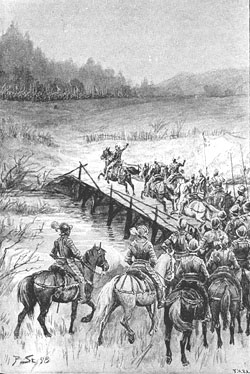Battle of Stångebro
| Battle of Stångebro | |||||||
|---|---|---|---|---|---|---|---|
| Part of War against Sigismund | |||||||
 |
|||||||
|
|||||||
| Belligerents | |||||||
|
|
(Separatists) |
||||||
| Commanders and leaders | |||||||
| King Sigismund | Duke Charles | ||||||
| Strength | |||||||
| 5,200 men | 9,000 men | ||||||
| Casualties and losses | |||||||
| About 500 killed and wounded | 40 killed, 200 wounded |
||||||
The Battle of Stångebro, or the Battle of Linköping, took place at Linköping, Sweden, on 25 September 1598 and effectively ended the personal union between Sweden and the Polish–Lithuanian Commonwealth, that had existed since 1592. In the battle, an army of c. 8 ,000–12,000 commanded by Duke Charles defeated a mixed force of c. 5,000–8,000 consisting of an invading army of mercenaries in the king's employ and diverse but poorly co-ordinated supporting Swedish noblemen's forces commanded by King of both Sweden and the Polish–Lithuanian Commonwealth Sigismund III Vasa, who was acting to maintain and restore his personal union against anti-Catholic forces in Lutheran Sweden. The Swedish kings general Constantin fought at the western bridge.
The battle was the beginning of the seven decades long Polish–Swedish Wars, which eventually destroyed the Polish-Lithuanian Commonwealth, at the time, arguably the largest nation state in Europe. Like the Thirty Years' War which also involved Sweden, under the surface, the dynastic struggles were rooted firmly in religious strife between Protestants and Roman Catholics.
Sigismund was captured during the battle, but as the Polish-Lithuanian crowned head of state, allowed to return to the commonwealth. He'd engendered the civil war by violating his pledge to not interfere in religious matters in Sweden, nor to further the Catholic cause in Sweden.
When King John III of Sweden died in 1592, his son Sigismund inherited the throne, despite his Catholic upbringing and despite already being King of Poland-Lithuania. However, he was refused coronation unless he agreed to the conditions of a clerical convention in Uppsala, making Sweden decisively Protestant. The debate was resolved in 1594, and freedom of religion was proclaimed, although only Protestants could hold high offices. The Swedish nobility also sought greater freedom and privileges. They were not granted these, but in the absence of the king, who spent most of his time in Poland, Sweden was to be ruled jointly by the Privy Council and Sigismund's uncle, Duke Charles. At the Riksdag in Söderköping, summoned against the will of the king, Duke Charles was elected regent in the king's absence. This was protested by Sigismund and those nobles loyal to him (mostly found in Finland after the king's governor, Klaus Fleming, had put down a peasant uprising there).
...
Wikipedia
